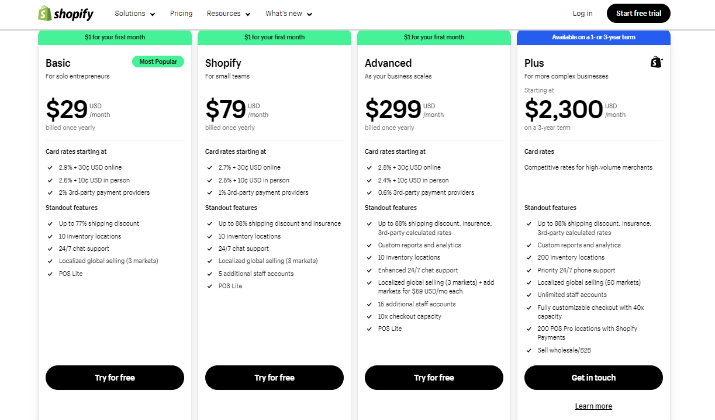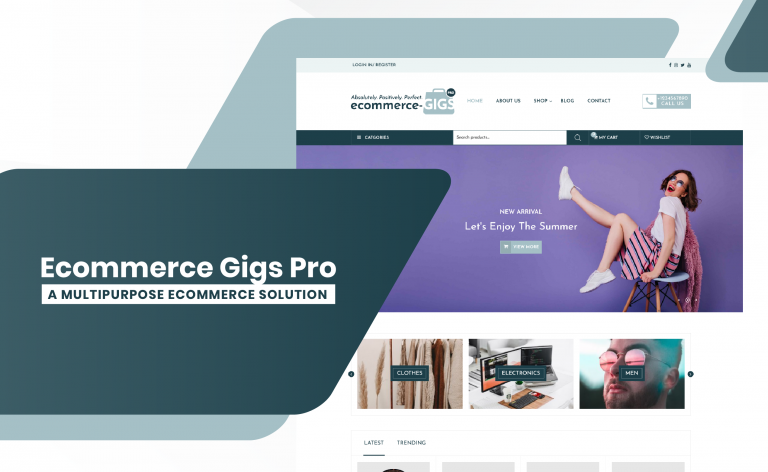As the world of ecommerce continues to evolve, businesses are faced with the challenge of selecting the right ecommerce platform to sell their products online.
Two of the most popular options are Shopify and Lazada, both of which offer a range of features and benefits to help merchants succeed in the digital marketplace.
But which is best for your business?
Join us as we will delve into the key features, pricing, and benefits of both Shopify and Lazada, helping you determine which ecommerce platform is the best fit for your business needs and goals.
Whether you’re a seasoned ecommerce veteran or just starting out, this comparison will provide valuable insights to guide your decision-making process.
Let’s dive in.
Introduction
Shopify
Shopify is an all-in-one ecommerce platform that allows users to build online stores, manage sales, market to customers, and accept payments in digital and physical locations.
It prioritizes flexibility, enabling users to add the functionality they need for their businesses, with the option to personalize themes, build custom apps, and create rich experiences.
Shopify connects sellers, developers, business experts, and shoppers to enhance commerce for everyone, making entrepreneurship more accessible to a wide range of individuals, from creators to established brands.
The platform offers tools for customer engagement, marketing insights, B2B management, and more to help businesses grow and thrive.
Additionally, Shopify provides various features like free and paid themes, apps, payment processing, and sales channels to cater to different business needs.
Shopify’s key features include tools for setting up and running businesses, selling through different channels, and accessing a dedicated support team available 24/7.
Also read: Shopify vs Instamojo
Try Shopify free followed by first month at just $1. No credit card required. Limited Time Offer.
Lazada
Lazada is an international ecommerce company founded in 2012 by Maximilian Bittner. It operated as a marketplace platform that initially sold inventory from its own warehouses but later transitioned to allow third-party retailers to sell on its platform.
Lazada is a major player in Southeast Asia’s ecommerce market, with a significant presence in six countries: Indonesia, Malaysia, the Philippines, Singapore, Thailand, and Vietnam.
In 2016, Alibaba Group acquired Lazada, further boosting its international expansion efforts.
Lazada offers a wide range of products, multiple payment options, a return program, and nationwide shipping, making it a prominent competitor to Amazon in the Asia-Pacific region,
Check out: Ecwid vs Adobe Commerce
User Base
Shopify
Shopify is a popular ecommerce platform used by over 2 million sellers, with more than 4.61 million live websites using Shopify. The majority of these websites are registered in the United States, followed by the United Kingdom and Australia.
It has over 13,000 apps available for download in the Shopify App Store, and it processes more than $500 billion in Gross Merchandise Volume (GMV) yearly, with 561 million unique customers coming through Shopify-powered stores.
Shopify has more users and reaches more markets than Lazada. It’s well-loved in areas like Lifestyle, Computers, Electronics & Technology, and more, including over 20 categories.
Lazada
The user base of Lazada is estimated to be around 200 million users across six Southeast Asian countries, including Malaysia, the Philippines, Singapore, Thailand, and Vietnam.
By 2030, Lazada aims to expand its user base to serve 300 million customers.
Explore: Shopify vs Shopware
Shopify holds a significant market share in the ecommerce industry. It leads in market share among Top 10K, Top 100K, and Top 1M Sites.
It claims a 10% ecommerce market share in the US and a 6% market share in Western Europe. Among all ecommerce websites, Shopify holds a 26% market share, making it the most popular platform for ecommerce businesses.
Additionally, Shopify has about 10.3% market share in the USA when considering Gross Merchandise Volume (GMV).
Lazada, on the other hand, has much lower market share. It is yet to beat Shopify in any category or country. Despite facing challenges and increased competition, Lazada remains a significant player in the e-commerce industry, particularly in Southeast Asia.
Read this too: Sellfy vs Gumroad
Ecommerce Features & Capabilities
Shopify
Shopify is known for its extensive features and capabilities that cater to the needs of online businesses. Here are some key features and capabilities of Shopify:
- Easy to Set Up: Shopify offers a user-friendly interface with drag-and-drop options, mobile commerce compatibility, over 100 payment gateways, multiple languages, and unlimited bandwidth.
- Easy to Manage: Shopify automates backend operations, including shipping charge calculations, tax calculations, and allows for remote store management. Users can customize their store using HTML and CSS and manage their store on the go with the mobile manager.
- Boosting Sales: Shopify contributes to increasing sales by enhancing SEO optimization, integrating social media for direct selling, and providing fast-loading pages that are SEO-friendly.
- Security Features: Shopify ensures strong security with a free 256-bit SSL certificate, level 1 PCI compliance, secure transactions, and enhanced search engine rankings
- Analytic and Customer Engagement: Shopify offers analytics tools to track store performance, customer behavior, and marketing effectiveness. It includes abandoned cart reminders for re-engaging with customers and improving conversion rates.
- Mobile Commerce: Shopify is an ideal mobile commerce partner due to its mobile app development capabilities, allowing users to run their store efficiently on mobile devices
These features make Shopify a comprehensive ecommerce platform that caters to various aspects of online business management, from setup and management to security, sales optimization, and mobile commerce capabilities.
Also read: Sellfy vs Stan Store
Try Shopify free followed by first month at just $1. No credit card required. Limited Time Offer.
Lazada
Lazada offers a range of features and capabilities that cater to buyers, sellers, and administrators. These features are designed to enhance the overall ecommerce experience, facilitate sales, and streamline management operations.
- Marketing Strategies and Advertisement Platform: Lazada has implemented various marketing strategies to boost sales on the platform, benefiting sellers. The platform allows sellers to display advertisements to increase brand visibility and offers an affiliate program to further promote products.
- Initiatives and Business Strategies: Lazada has introduced several initiatives, such as Lazmall, LazGlobal, and the availability of downloadable digital products, to expand its ecommerce offerings.
- Cross-Border Business and Logistics: Lazada’s cross-border business features homegrown brands and sellers from markets including China, Hong Kong SAR, Korea, Japan, the United States, and Europe.
- Advertising Solutions: Lazada offers self-serve advertising platforms where businesses can create and manage their advertising campaigns. These platforms use a cost-per-click (CPC) model, allowing businesses to target specific audiences based on demographics, interests, location, and behavior.
Lazada’s ecommerce features and capabilities are designed to provide an intuitive experience for buyers, facilitate sales for sellers, and streamline management operations for administrators.
The platform’s marketing strategies, advertisement platform, initiatives, and business strategies have contributed to its success as a leading ecommerce platform in Southeast Asia.
Check out: Shopify vs mijndomein
Ease of Use & Setup
Shopify shines in ease of use when setting up an ecommerce platform. It offers a simple, intuitive design.
With features for inventory, SEO, and accepting various payments, it’s perfect for beginners. Even if you’re not a tech pro, you can make your online store standout.
In comparison, Lazada might not be as straightforward for everyone. It’s an online marketplace with lots of products from different sellers.
For store owners, it could mean more work and tech knowledge. This is unlike Shopify, which is an all-in-one solution.
On the whole, Shopify is favored for its user-friendly design and features. It’s easy to start and run your ecommerce store using it.
Yet, if you prefer marketplaces or you’re used to online selling, don’t overlook Lazada as an option.
Explore: Shopify vs Fourthwall
Customer Support & Resources
Shopify has step-by-step guides, helpful video tutorials, and a big community forum. This enables merchants to meet and learn from each other. They can also get advice from Shopify experts.
Shopify gives 24/7 support through email, chat, and phone. Their support team is quick to respond. They also really know their stuff. They help merchants solve problems and make their online stores better.
Lazada’s support has resources for sellers too. They can find guides, tools, and the best ways to run their Lazada shop in the seller center.
Lazada provides reliable customer support to help customers with their inquiries, concerns, and order-related issues.
Customers can get in touch with Lazada’s customer service team through phone, email, and live chat. The platform aims to offer a safe, seamless, and enjoyable online shopping experience in Southeast Asia for businesses of all sizes.
Read this too: Neto vs Shopify For B2B
Try Shopify free followed by first month at just $1. No credit card required. Limited Time Offer.
Integrations & Add-Ons
For Shopify, there’s a whole world of apps and integrations.
They help with everything from spreading the word about your online shop, to analyzing sales, to making sure packages get to customers on time. You can link your store to services you’re already using, like Google Analytics, Mailchimp, Xero, and Shippo.
Lazada, being an ecommerce marketplace, provides useful and relevant tools for managing ecommerce operations.
You can integrate common payment systems, delivery services, and social media. This means you’re better connected with your customers across many platforms.
Also read: GoDaddy vs Shopify
Pricing
Shopify
Here is a look at the pricing plans from Shopify:
- Basic Plan: This plan comes at a price of $39 per month or $29 per month if billed annually. The plan is intended for new entrepreneurial ventures and offers essential features to set up an ecommerce store.
- Shopify Plan: With a pricing of $105 per month or $79 per month if paid annually, this plan is suitable for fast-growing ecommerce stores. It offers more advanced features than the Basic Plan.
- Advanced Plan: This plan will cost you $399 per month or $299 if billed yearly. The plan with advanced tools and features is a perfect option for fast-growing business.
- Plus Plan: Costing $2300 per month, this plan has been designed to meet the demands of enterprise-level businesses with high-volume sales. It provides premium features and services.
Additionally, Shopify charges transaction fees based on these plans:
- Basic: 2.9% + 30¢ per transaction
- Shopify: 2.7% + 30¢ per transaction
- Advanced: 2.5% + 30¢ per transaction
- Plus: Custom pricing
Also read: Ecwid Coupon Code
Try Shopify free followed by first month at just $1. No credit card required. Limited Time Offer.
Lazada
The Lazada fees for sellers includes commission fees, transaction fees, shipping, marketing, and fixed fees per item.
The commission fees ranges from 1% to 5% for marketplace sellers in the Philippines and 3% to 7% for LazMall sellers. Transaction fees is set at 2.24% for all Philippines sellers.
Lazada supports multiple payment methods such as credit/debit cards, online banking, e-wallets, Cash on Delivery, Installments, and Lazada Wallet.
Sellers can tailor products, descriptions, shipping times, and prices to cater to different regions.
Read this too: Shopify vs Salla
Conclusion
Both Shopify and Lazada, have their own strong points.
If you want a powerful online store that you can fully control, Shopify might be the best fit.
Yet, for those wanting to reach more customers in Southeast Asia, choosing Lazada could be smart. Before choosing one, think about what your business wants to achieve and who your customers are.
This will help you make the right choice.
















